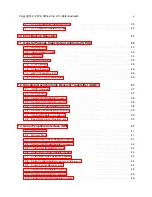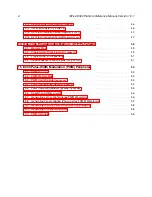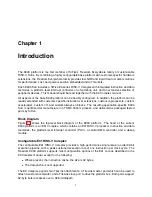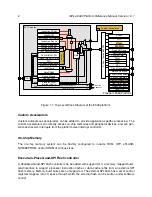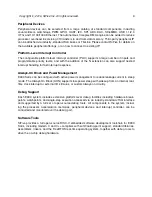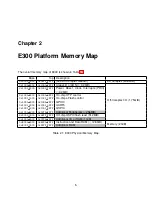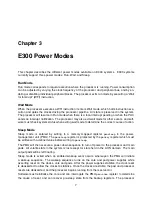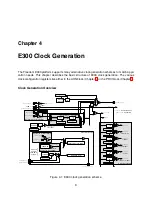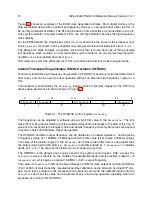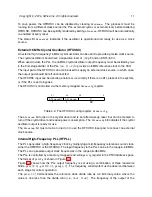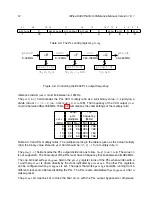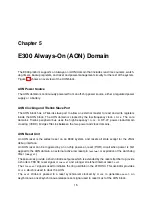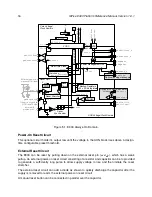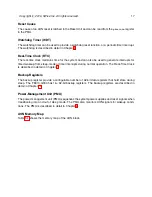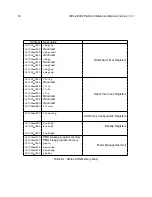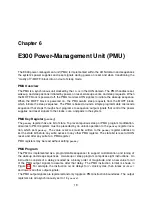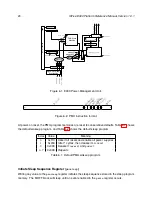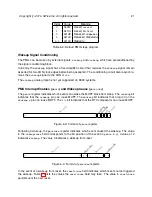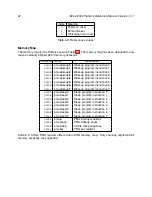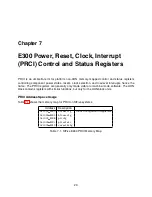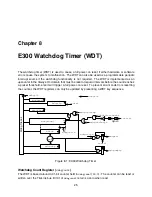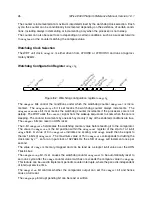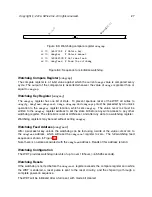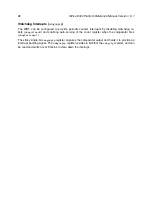
Copyright
c
2016, SiFive Inc. All rights reserved.
13
When
pllsel
is clear, the
hfroscclk
directly drives
hfclk
. The
pllsel
bit is clear on wakeup
reset.
The
pllcfg
register is reset to: bypass and power off the PLL
pllbypass
=1; input driven from
external HFXOSC oscillator
pllrefsel
=1; PLL not driving system clock
pllsel
=0; and the PLL
ratios are set to R=2, F=64, and Q=8 (
pllr
=01,
pllf
=011111,
pllq
=11).
The PLL provides a lock signal which is set when the PLL has achieved lock, and which can be
read from the most-significant bit of the
pllcfg
register. The PLL requires up to 100
µ
s to regain
lock once enabled, and the lock signal will not necessarily be stable during this initial lock period
so should only be interrogated after this period. The PLL may not achieve lock and the lock signal
might not remain asserted if there is excessive jitter in the source clock.
The PLL requires dedicated 1.8 V power supply pads with a supply filter on the circuit board.
The supply filter should be a 100
Ω
resistor in series with the board 1.8 V supply decoupled with
a 100 nF capacitor across the VDDPLL/VSSPLL supply pins. The VSSPLL pin should not be
connected to board VSS.
PLL Output Divider
The
plloutdiv
register controls a clock divider that divides the output of the PLL.
0
31
9
plloutdivby1
8
0
7
6
plloutdiv
5
0
Figure 4.3: PLL Output Divider Register
plloutdiv
If the
plloutdivby1
bit is set, the PLL output clock is passed through undivided. If
plloutdivby1
is clear, the value
N
in
plloutdiv
sets the clock-divide ratio to 2
×
(
N
+ 1)
(between 2–128). The
output divider expands the PLL output frequency range to 0.375–384 MHz.
The
plloutdivby1
register is reset to divide-by-1 (
plloutdivby1
=1)..
Internal Low-Frequency Oscillator (LFRCOSC)
An untrimmed internal low-frequency RC oscillator can be provided with an operating frequency
of 40-80 kHz. The internal low-frequency oscillator can be used to clock the always-on domain in
lieu of an external crystal. A programmable prescalar is provided to allow runtime calibration of
the low-frequency output to improve timing accuracy.
External 32.768 kHz Low-Frequency Crystal Oscillator (LFXOSC)
A 32.768 kHz external crystal oscillator can be attached to provide a precise real-time clock. The
oscillator can be turned off to save power but can require up to 1 s to stabilize.
Summary of Contents for E300
Page 1: ...SiFive E300 Platform Reference Manual Version 1 0 1 c SiFive Inc ...
Page 2: ...2 SiFive E300 Platform Reference Manual Version 1 0 1 ...
Page 4: ...ii SiFive E300 Platform Reference Manual Version 1 0 1 ...
Page 12: ...4 SiFive E300 Platform Reference Manual Version 1 0 1 ...
Page 14: ...6 SiFive E300 Platform Reference Manual Version 1 0 1 ...
Page 22: ...14 SiFive E300 Platform Reference Manual Version 1 0 1 ...
Page 32: ...24 SiFive E300 Platform Reference Manual Version 1 0 1 ...
Page 40: ...32 SiFive E300 Platform Reference Manual Version 1 0 1 ...
Page 56: ...48 SiFive E300 Platform Reference Manual Version 1 0 1 ...
Page 60: ...52 SiFive E300 Platform Reference Manual Version 1 0 1 ...

